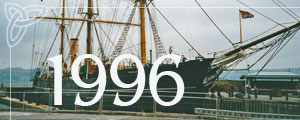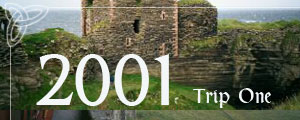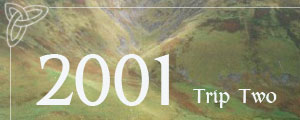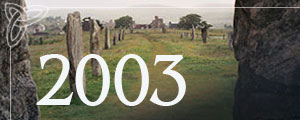2001 Tour - Part Two
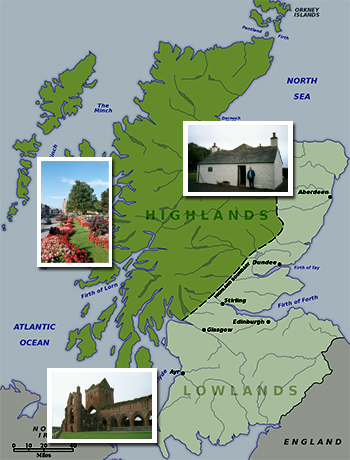
Isle of Arran
Alloway
Kirkcudbright
Dumfries
Carlisle
Annan
Moffat
Innerleithen
Tweed Valley
New Lanark
Glasgow
Accompanying text, written by Alice Jean Matuszak, as it appeared in The Holly Leaf.
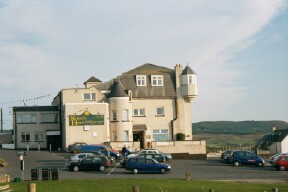
Isle of Arran Hotel
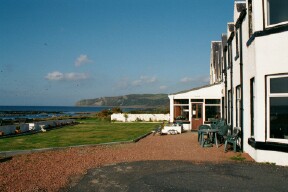
View from Isle of Arran Hotel
Isle of Arran
September 19, 2001
Four clan members, Guy and Betty Irvin and Charles and Jean Matuszak, picked up a mini-van at the Glasgow airport and drove southwest to Ardrossan to take the Caledonian MacBrayne Ferry for the 30-minute trip across the Firth of Clyde to Brodick on the Isle of Arran.
“The earth belongs unto the Lord,
and all that it contains,
Except the western highland piers,
and they are all MacBraynes.”
The Isle of Arran, 25 miles long and 10 miles wide, is often called "Scotland in Miniature" because of its varied scenery - mountains, lochs, glens, moors, sandy beaches, and rocky coasts. Warmed by the Atlantic Drift (Gulf Stream), Arran has a climate for growing wonderful flowers, shrubs and trees including palm trees. Its gardens, such as those at Brodick Castle, are famous and gorgeous.
From Brodick we took the String Road across the center of the island to the Kinloch Hotel at Blackwaterfoot overlooking Kilbrannan Sound and our home for two nights. We greatly enjoyed the amenities of the hotel including the swimming pool and the views of water birds and seals.
September 20, 2001
This day was spent in taking a counter-clockwise, circle tour of the island. We enjoyed our visit to Brodick Castle, ancient seat of the Dukes of Hamilton. The entry stairs displayed a huge collection of mounted deer heads. Various rooms were filled with antiques and paintings recounting the life and interests, such as horse racing, of this family.
The Castle was built on the site of a Viking fortress and parts of it date from the 13th Century. It stands on the east sidee of the Isle of Arran, overlooks Brodick Bay and has a view of 2866-foot Goatfell mountain. We especially enjoyed the lovely gardens with their wonderful blue hydrangeas. Our island tour included stops at Brodick for ice cream, lunch at Corrie and a visit to the Old Byre Showroom, Auchencar Farm, Machrie for knitted garments.
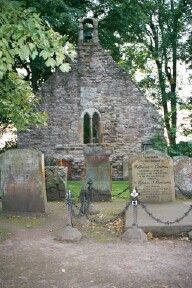
Alloway Auld Kirk
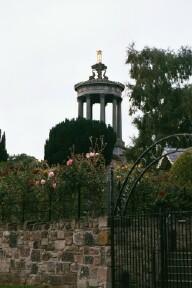
Robert Burns Monument
Alloway
September 21, 2001
We returned from Brodick to Ardossan on the Cal-Mac ferry and headed south through the town of Irvine to Ayr and Alloway where we stayed at the Greenan Lodge B&B for two nights. The day was spent in visiting sites connected with Robert Burns, The National Poet of Scotland, including the cottage where Rabbie was born January 25, 1759, the Burns' Monument, Alloway Auld Kirk where his father is buried, the Brig o'Doon and the Tam o'Shanter Experience. The latter features a multiscreen film about Burns' life and a reading of his famous poem complete with scenes of witches in the ruined Auld Kirk and one of them called Cutty Sark chasing Tam and his mare Meg as far as the river flowing under the Auld Brig. Witches cannot cross running water so Tam escapes but Meg loses her tail in the process.
At the Brig o'Doon Hotel we had dinner that included cullen skink, haggis with neeps and tatties and wonderful salmon. The grounds gave great views of the lovely garden and the Auld Brig.
September 22, 2001
We drove south from Alloway along the coast with a brief tour of the ruins of Dunure Castle and dovecote to the magnificent Culzean Castle (pronounced Cul-lane) standing on the cliff's edge overlooking Culzean Bay. Robert Adam, the renowned architect, redesigned and converted the tower house (1590s) into an elegant residence for David Kennedy, 10th Earl of Cassillis, between 1777 and 1792. Upon entering the Castle one comes into the Armoury with a spectacular display of weapons arranged on the walls. These include Light Dragoon flintlock pistols, hanger swords, Heavy Dragoon flintlock pistols and sword and bayonet blades. Especially noteworthy among the many Adam's rooms are the Circular Saloon with its superb view of the Firth of Clyde and the magnificent Oval Staircase, both restored to their original colour schemes.
In 1945, the Kennedy family gave Culzean to the National Trust for Scotland and gave the top floor to General Dwight D. Eisenhower (for his use) as a token of Scotland's recognition of his role during World War II. The grounds surrounding the Castle include a walled garden, deer park and swan pond.
September 23, 2001
We headed south from Alloway, past Turnberry of golfing fame and through Girvan while trying to catch a glimpse of Ailsa Craig (Gaelic for Fairy Mountain) through the fog that covered the Firth. This interesting island, a volcanic plug, is noted for supplying the granite turned into official stones for the sport of curling.
We continued south through Ballantrae and then east to the ruins of the Cistercian Glenluce Abbey, which was founded by Roland, Lord of Galloway, about 1192. The present structure was built about 1500. We continued southeast along Luce Bay, past Whithorn then north to Wigtown for lunch. Our visit coincided with The Scottish Book Town Festival and we took the opportunity to check out the books in a few of the town's 22 book stores.
We drove north to Newton-Stewart and to the Corsbie Villa B&B. We were greeted by Charlie, a friendly orange marmalade cat with white feet. Our hosts directed us to the Galloway Forest Park with beautiful vistas, a field of goats and the chance of spotting deer.
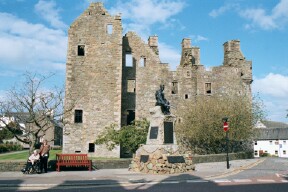
MacClellan Castle
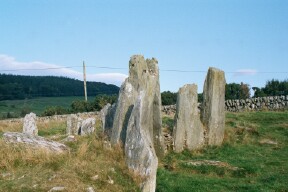
Cairn Holy I
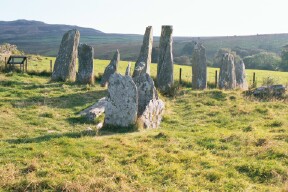
Cairn Holy II
Kirkcudbright
September 24, 2001
After our excellent Scottish breakfast and a stop to photograph some beautiful blue-purple hydrangeas, we headed east along Wigtown Bay and a visit to Cairnholy I, considered "the best of the Clyde group of long cairns in the region." It included an inner burial chamber with massive side-slabs and a concave horned facade of eight tall pillars.
We crossed the Water of Fleet and the Gatehouse of Fleet and continued on to the beautiful town of Kirkcudbright (pronounced Kir-coo-bree) where the River Dee flows into Kircudbright Bay. With its lovely flowers, interesting houses and shops, ruined MacClellan castle dating from 1582 and harbor-side views, it was easy to see why this area has long been a favorite of painters. Interestingly, the author Dorothy Sayers used this area for one of the Lord Peter Wimsey mysteries, The Five Red Herrings.
We drove to Castle Douglas where we had Cocky Leeky soup for lunch at the Douglas Arms. We spotted the Irving Bakery, stocked up on delicious sweets and were off to find the Craigadam Hotel, which was our home for the next four nights. This lovely hotel turned out to be a "shooting lodge" and it was quite interesting to see the hunters with their bag of pheasants and partridges at the end of the day.
Our dinner, served family style at an enormous table in the dining room, included haggis with neeps and tatties, delicious lamb and vegetables and a wonderful molded dessert made with homemade ice cream. Coffee was served to guests in the lounge where a fire in the fireplace provided additional ambiance. Bedrooms had been recently redecorated different styles; Guy and Betty had the Highland Room with Scottish decorations and tartan; Charlie and Jean were in the Chinese Room with lacquered furniture and Chinese decorations. The rooms also had electric mattress pads which made it more pleasant for some of the party.
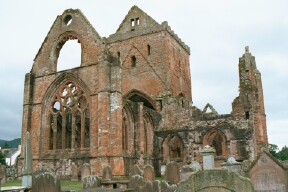
Sweetheart Abbey
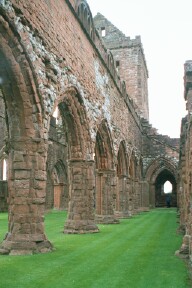
Sweetheart Abbey
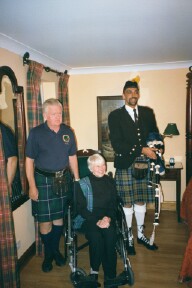
Guy and Betty and Piper
Dumfries
September 25, 2001
Today we drove through Castle Douglas and Dalbeattie, past the Mersehead Sands, to Kirkbean and the Museum at Arbigland on Solway Firth. In 1747 in the small gardener's cottage of the estate John Paul, junior, son of John Paul and his wife Jean, was born. This boy, better known as John Paul Jones, is regarded as the founder of the American Navy and played a significant role as American commander in naval battles during the Revolutionary War, many of which were fought in Solway Firth. The reconstructed cottage has been furnished as it would have been in the 18th century.
The museum also contains a room representing the cabin of Jones' ship "Bonhomme Richard" in which Jones defeated the British HMS Seraphis off Flamborough Head, Yorkshire in 1779. An audiovisual program of the battle recalls under what conditions Jones spoke the words, "I have not yet begun to fight," when he was asked during the battle by Peason, Commander of the Seraphis, "Sir, do you ask for quarter?" The program and house, opened to the public in 1993, are well worth seeing.
Today we see ruins of these once magnificent buildings, constructed of the local red sandstone and beautifully carved into columns and elaborate windows. They stand on brilliant green turf so thick it looks like moss.
We went north to the town of Dumfries on the River Nith to visit the various sites associated with the later life of Scottish poet Robert Burns. We started with an interesting film on Burns' life at the Robert Burns Centre located in the old burgh mill on the River Nith and then had lunch at the pub in the Globe Inn tucked away in a narrow alley off the High Street. Burns' "Howff" and the Snug Bar are said to retain much of the 18th century atmosphere when Burns was an "honoured favoured guest."
We toured the Burns' House where he and his family lived from May 1793 until his death on July 21, 1796. Our earlier visit to Alloway plus our experiences in Dumfries have given us a greater appreciation of the life of this famous man and the difficulties he faced as a creative man who needed to earn a living to support his family.
From Dumfries we returned to the Craigadam Hotel where a real surprise awaited us. The hotel owners had arranged to have a piper, complete to a shade in his Highland kilt, play a special program for our party. What a treat! Dinner was also outstanding, with a lovely Game Meat Casserole that contained pheasant, grouse, partridge and venison and a sticky toffee pudding for dessert.
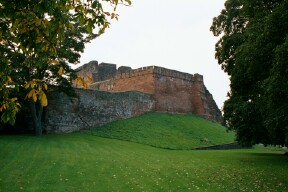
Carlisle Castle
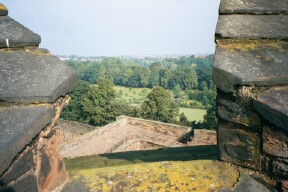
Carlisle Castle Battlements
Carlisle
September 26, 2001
We met Dr. Bruce Irving and drove with him to Carlisle Castle and tried to imagine what it was like in the 1500s during the height of the Border Reivers' activities. This area on the River Eden has long been considered an important one to fortify against Scots making forays south into England. The earliest fortifications on this site date from the 1st century as the Romans kept a garrison for some 300 years at this place they called Luguvalium. Apparently the Roman fort and town were still standing when St. Cuthbert, bishop of Lindisfarne, visited Carlisle in 685. William II of England (William Rufus) built the 1st timber castle at Carlisle in 1092. His brother Henry I had a castle and towers built of stone beginning in 1122.
Along with northern counties of England, Carlisle became part of Scotland during the reign of Scotland's Kind David I with the castle keep and city walls being completed during this time period. David died at Carlisle in 1154 and his son, Malcolm IV (The Maiden), lost Carlisle and this region in 1157 to the English King Henry II. With the castle now back in English hands, it played a powerful role in subsequent wars, both Anglo-Scottish and Civil. As headquarters of the English Warden of the West March and as a fortress prison it figures in tales of the Reivers of the West March.
One of the most famous tales is that of the rescue of Kinmont Willie Armstrong from Carlisle Castle prison the night of April 13, 1596, by a varied group of Armstrongs, Grahams, Scotts, et al, led by Walter Scott of Buccleugh who also happened to be the Warden of the Scottish Middle March. It is said that several Irvines/Irvings also took part in this famous rescue.
After a climb to the battlements of the Keep, we walked through a new underground walkway from the castle to Tully House Museum. This walkway is paved with blocks of stone that bear the names of the famous "Riding/Reiving" families including Irving, Irvine, and Glendenning. There is also a boulder upon which is printed the famous "Monition of Cursing" of the Archbishop of Glasgow.
The days of the reivers were numbered when King James VI of Scotland succeeded Elizabeth I in 1603, a time called the "union of the crowns." James was especially harsh on members of reiving families, hanging some without benefit of trial, shipping many off to Ulster plantation in Ireland and ultimately dispersing them to American colonies. Many Scots-Irish-Americans have roots that go back to this time and place.
Tully House Museum has excellent displays ranging from stone-age to Roman to an excellent audio-visual program on the life and times of the Reivers.
After lunch we headed north to the Annandale Museum in Annan where Bruce showed us an interesting display on the sandstone industry and its history in Dumfriesshire. We learned that lower Annandale and the valley of the Kirtle Water are underlain with a bed of New Red Triassic Sandstone formed in water and termed 'water lain' and that this newly-quarried sandstone is soft and much favored by sculptors because it is fine grained and takes a smooth finish. When it hardens it becomes strong and weather resistant. Nithsdale and Upper Annandale have New Red Permian Sandstone that is termed 'dune bedded' because it was formed under different drier conditions. There are also other colors of building sandstone in this area. We also learned that many buildings in Dumfries, Annan, and Lockerbie as well as Sweetheart Abbey and Caerlaverock have been built with the sandstone and that the Corsehill Quarry supplied the beautiful red sandstone used in Albany, New York to make the "Million-dollar" staircase in the New York State Capitol building.
After viewing the exhibit we found ourselves speculating as to the origin of the sandstone used in construction of the many buildings, monuments and castles we saw.
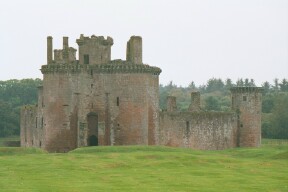
Caerlaverock Castle
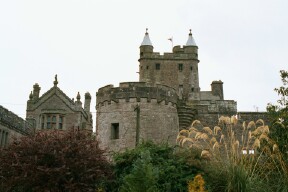
Hoddam Castle
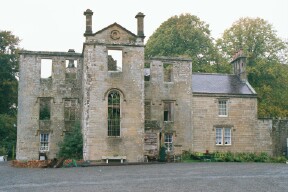
Cove Castle
Annan
September 27, 2001
This morning we toured Caerlaverock Castle (pronounced Car-lav-er-ock) overlooking the Solway Firth. The estate at Caerlaverock was granted to Sir John De Maccuswell about 1220 with a castle being built, which was abandoned shortly thereafter and a new one built on the present site. The Castle was the principal seat of the Maxwell family and stayed with them for 400 years. Built of beautiful red sandstone, the castle is in the shape of a shield, with three sides round it, a tower at each corner and a double tower at the gate which was protected by a drawbridge over the inner moat. It figured in many of the Anglo-Scottish battles as well as those fought between the Scots. The castle was partially dismantled by the Covenanters after the 1640 siege. Today it exists as a romantic ruin under the care of Historic Scotland.
We then drove to Annan where we began our tour of Irving Country and the Irving Towers on the Kirtle Water with our kinsman, Dr. Bruce Irving of Bonshaw, who is knowledgeable about genealogy and history of this area. Our day included viewing the following sites which have been associated with the Irving family: Hoddam Castle, Robgill, Woodhouse, Stapleton and Cove. We also saw Repentance tower, the statue of Thomas Carlyle and his birthplace, the Arched House at Ecclefechan. We joined Dr. Margaret Irving for drinks at Bonshaw and dinner at the Dryfesdale Country House Hotel, Dryfebridge, Lockerbie. We enjoyed seeing Bonshaw again. We greatly appreciated having Bruce with us for our two-day tour of Irving and Border Reiver country.
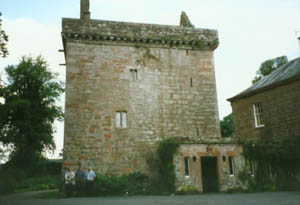
Bonshaw Tower
Bonshaw Tower
The Irvings of Bonshaw were Chiefs of the Border Irvings, a small clan that greatly increased in size and importance during the 16th century. The present stone tower was built in the late 1560s by Edward Irving. By this time the Irvings had become close allies of the Johnstons in their feud with the Maxwells. The tower is located about one-half mile SE Kirtlebridge. The site is naturally strong standing 70 ft. above the Kirtle Water on the east side and with a deep ravine on the south side. The other two sides probably had the usual outer defenses of ditch, rampart and palisade, which were finally destroyed when the present mansion was built and the gardens laid out in 1770.
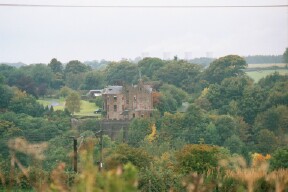
Robgill Tower
Robgill Tower
In 1536 the Corries sold the lands of Robgill and Stapleton to William Johnston of Gretna. In 1547 Cuthbert Urwen of Robbgill is mentioned in records. The Irvings built the present tower with a design similar to that of Bonshaw but, presumably, at a later date. It stands on a cliff on the right bank of the Kirtle Water, about one mile SE Kirtlebridge.
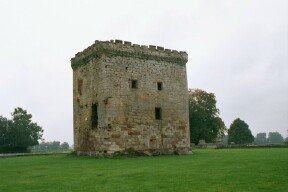
Stapleton Tower
Stapleton Tower
In November 1536, William Johnston alienated 'the lands of Stabiltoun' to Christopher Irving of Bonshaw. Stapleton tower is said to have been built by Edward Irvine probably around the time of the Irvings' local war with the Maxwells in 1585-86, or even later. The tower is located about 2 and 3/4 miles E-NE Annan, located on gently rising ground overlooking the Solway. Apparently any traces of fortifications were destroyed when a mansion was built; this mansion was demolished after World War II.
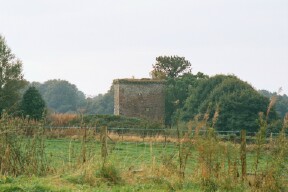
Woodhouse Tower
Woodhouse Tower
In 1574 John Johnston sold the lands called 'Wodhous Johnnestoun' to Edward Irving of Bonshaw. The tower dates from the latter part of the 16th century, most likely after the Irvings purchased the property. Woodhouse Tower stands above the Kirtle Water, almost opposite to Robgill and in full view of Bonshaw and Wyseby, only 3/4 mile upstream. For additional information on the Irving towers see The Border Towers of Scotland: the West March by Alastair M. T. Maxwell-Irving (2000).
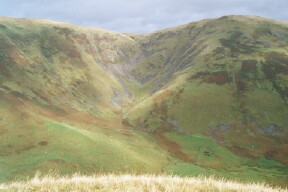
Devil's Beef Tub
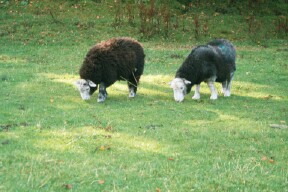
Sheep Grazing
Moffat
September 28, 2001
We drove north through Moffat to see the "Devil's Beef Tub." Foggy conditions prevented our seeing it so we returned to Moffat for some sightseeing that included the famous Ram statue that was cast without its ears. We headed south to take some additional photos of Robgill across the Kirtle Water and Woodhouse. We also viewed Kirkconnel now called Springkill, which has Irving connections.
We had lunch at Gretna Green and a tour of the museum with the famous Blacksmith's anvil over which runaway English couples used to be wed.
We drove through Longtown to Bessietown Farm B & B at Catlowdy which was our home in England for two nights. We were greeted by three cats, a very large grey tiger, an all-grey and a grey and white.Our rooms, part of a two-story, self-catering cottage, were located in a remodeled stable block, which was decorated with flowers in hanging baskets and in a wheelbarrow.
We drove south to Hadrian's Wall to see the Carvoran Roman Army Museum at Greenhead near Haltwhistle. We enjoyed the exhibits, artifacts associated with the Roman occupation and especially the "Recruiting" film extolling the benefits of joining the Roman Legions. The day ended with dinner at Bessietown Farm that included delicious halibut with vegetables and one's choice of trifle or a banana split.
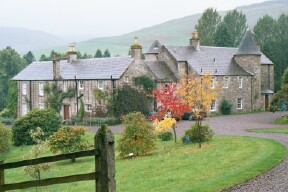
Westerhall House
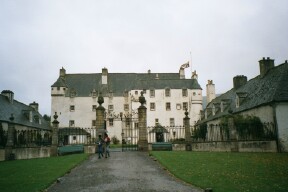
Traquair Castle
Innerleithen
September 30, 2001
After breakfast at Bessietown Farm we went in search of Westerhall House, a tower house that had been occupied by the Glendennings from the 14th century to the early 1600s. Westerhall was originally known as "Dalduran" and was part of the barony of Westerker (Watstirker) in the 13th century. The Glendennings acquired possession of Dalduran from the Douglasses sometime during the 14th century. "Glendenning and Dalduran were eventually sold by the Glendennings in 1605 to James Johnston of Westraw; in 1606 the name James Johnston of Westerhall first appears on record." (For additional information see The Border Towers of Scotland: the West March by Alastair M. T. Maxwell-Irving).
We actually located the house 4 1/2 miles northwest from Langholm on a secondary road on the east side of the River Esk between Burnfoot and Bentpath. The tower is incorporated into a lovely manor house that is part of a large estate. Nearby we discovered an old churchyard with several Glendenning and Irving gravestones. Our wonderings also led us past fields that contained dozens of partridges and pheasants. What a sight!
We drove north past Eskdalemuir, Johnstone and Ettrick with a side trip to St. Mary's Loch and tea at Tibby Shiels Inn. The pub was a favorite place for Sir. Walter Scott to meet James Hogg, the "Ettrick Shepherd." Then we drove north through Innerleithen to the wonderful Peebles Hydro Hotel, our home for two nights.
We retraced our path back to Innerleithen for lunch and a tour of Traquair Castle. The name comes from "Tra", a dwelling or hamlet and "Quair" is a tributary of the Tweed. This very interesting house, home of the Stuarts and Maxwell Stuarts, has many items associated with Scottish Kings and Queens including Mary Queen of Scots' rosary and crucifix plus petit point embroidery dating from 1600. There is also a priest's hole and secret staircase.
We also viewed the famous Bear Gates, which were closed one late autumn day in 1745 when Prince Charles Edward Stuart passed through after being a guest at Traquair. The gates remain closed to this day.
The wind through the rusted iron sings,
The sun on the self-sown tangle burns
But never a hoof on the roadway rings-
The gate is shut till the King returns.
- W. H. Ogilvie
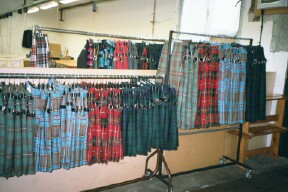
Tweed at the Loch Carron Mills
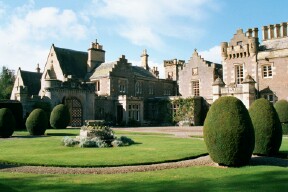
Abbottsford
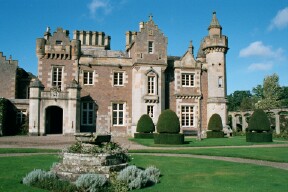
Abbottsford
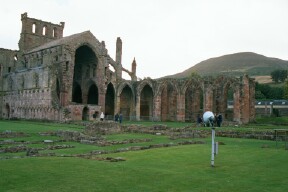
Melrose Abbey
Tweed Valley
October 1, 2001
After a wonderful cold and hot buffet breakfast at the Hydro Hotel we drove to Galashiels to the Lochcarron Mills, from which the Clan Irwin Association obtains their tartans. We had the opportunity of touring the mill and viewing the weaving of tartan starting with threads, finishing the cloth by washing and drying and tailoring kilts and other garments. It was also interesting to see the clothing and knitted woolen and cashmere sweaters in their shop.
We then went to Abbottsford to visit Sir Walter Scott's home. This is one of our favorite places in Scotland. It has Sir Walter's possessions and gives the impression that he has just stepped outside and will be back any minute. The walls are literally covered with his vast collection of Scotland historical artifacts. Especially appealing are the Great Hall adorned with arms and armour. The ceiling of the Great Hall is decorated with Coats of Arms of the Border Clans/Families including those of the Irvings and Glendennings. His study and library have a marvelous collection of books. The rooms on the river side of the house give glorious views of the Tweed River, which he loved so much.
We went to Melrose to tour Melrose Abbey, built by David I in 1136 for Cistercian monks and to replace a 7th century monastery. Built of rose-pink sandstone Melrose was one of the "most beautiful Border Abbeys." Its location made it vulnerable to English invasions. It was ransacked by English armies in 1322 and 1385, then given its death-blow by Henry VIII's instituting his policy of "rough wooing" in 1545.
The shell of the abbey church has some notable features- beautiful carved windows and pillars and interesting gargoyles such as the pig playing a bagpipe. The cemetery contains a burial site of an embalmed heart believed to be that of Robert the Bruce.
Following lunch at Burt's Hotel in Melrose we returned to Peebles for some shopping and to the Hydro Hotel for an elegant dinner that included dishes such as boar terrine, salmon, venison with red cabbage and hot apple pie with ice cream. The Peebles Hydro is actually the Peebles Hotel Hydropathic dating from its opening in 1881 as an elegant resort hotel where people came to take a "water cure." The original building burned down in 1905; the decision was made to rebuild reusing the red corncockle sandstone from Dumfriesshire. The hotel reopened in 1907. It is truly an elegant resort yet it has wonderful programs for families and for children. Its location in the Valley of the Tweed puts it close to famous Border's sites.
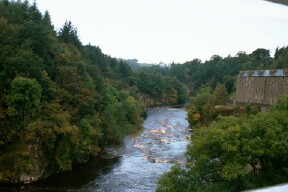
River Clyde
New Lanark
October 2, 2001
We drove from Peebles, through Selkirk and Hawick to Teviothead, where we discovered that the Museum of Border Arms and Armour had been dissembled. We did get to see a couple "steel bonnets" and a few swords on display in its former location. We continued south to Langholm, west to Lockerbie and north through Moffat to the Devil's Beef Tub, which is a box canyon that is said to have been used by the Johnstones to hold their cattle during Border Reiving days. This area is also known as the place where the River Tweed begins.
We headed north to Biggar and to the New Lanark World Heritage Village, where we spent the night in the New Lanark Mill Hotel overlooking the Clyde River. Located close to the Falls of Clyde, the 200 year old mill, where cotton and woolen thread and yarn were spun, and the village, where the workers lived, has been preserved as a living history center. It is also a monument to Robert Owen, mill owner and social pioneer, who believed in education for the workers and their families and helped establish a co-operative store for the workers. There was time for a self-guided tour of the Village and its exhibits before we had dinner at the New Lanark Mill Hotel.
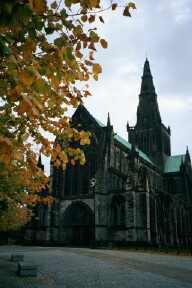
Glasgow Cathedral
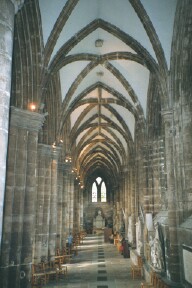
Inside Glasgow Cathedral
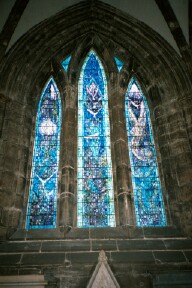
Glasgow Cathedral window
Glasgow
October 3, 2001
After breakfast at the New Lanark Hotel we drove to the home of the Chief of the Carmichael Clan; unfortunately he was not at home and unfortunately the Clan's museum and visitor center were not open. We did have a good view of their deer farm. Heading north and west to Glasgow we arrived at The Manor Park Hotel in Broomhill north of the Clyde River, our home for two nights.
After a lunch of "toasties" we went downtown Glasgow to Fraser's Department Store and bought two additional suitcases so we could ship through our various purchases. Dinner was at the Park Bar, a pub-meal of Fish and Chips, with 12 inch fish, or Beef and Guinness Pie that was about 10 inches across.
October 4, 2001
We spent the day sightseeing in Glasgow, starting with the Glasgow Cathedral, the present building dating from the 13th century. The early history of the Church in Glasgow and the Cathedral is associated with the legend of St. Mungo (St. Kentigern) who died in 612. Even the arms of the City of Glasgow were inspired by miracles attributed to St. Mungo including a robin he is said to have restored to life; a fish with a ring in its mouth associated with Queen Languoreth; the tree that he used to start a fire and his bell.
The Cathedral reminded us very much of St. Magnus Cathedral in Kirkwall in the Orkneys. The beautiful Cathedral building survived destruction by the Covenanters because the Glasgow Guilds of Craftsmen intervened on its behalf. We also visited the St. Mungo's Museum of Religion, which emphasizes diversity and understanding of the world's many religions. Among many famous works of religious art is Salvadore Dali's painting of Christ on the Cross.
We then drove to the Kelvingrove Park area where we toured the Museum of Transport or the Kelvingrove Art Gallery and Museum. The rest of the day was spent packing all those suitcases with clothing and the many purchases we'd been making for the last month. We had dinner at the Three Crows Pub that featured rib eye steak and a starter called "Texas Toothpicks."
October 5, 2001
After an excellent Scottish breakfast at the Manor Park Hotel B & B we packed up the minivan and headed for the Glasgow Airport. Checking our minivan's mileage we drove a total of 1356 miles during the 17 days of this trip. We saw a wide variety of scenery, stayed in several different types of accommodations and tried many types of traditional Scottish foods and some new types of cuisine. We learned that lunch is often a "toastie"-something like a good American grilled cheese sandwich. We survived a lot of rain and some fog plus we learned to really enjoy the days of sunshine.
Charley and Jean would like to express our many, many thanks to Guy and Betty for planning the itinerary, securing the lodgings and for guiding them on a wonderful adventure.


